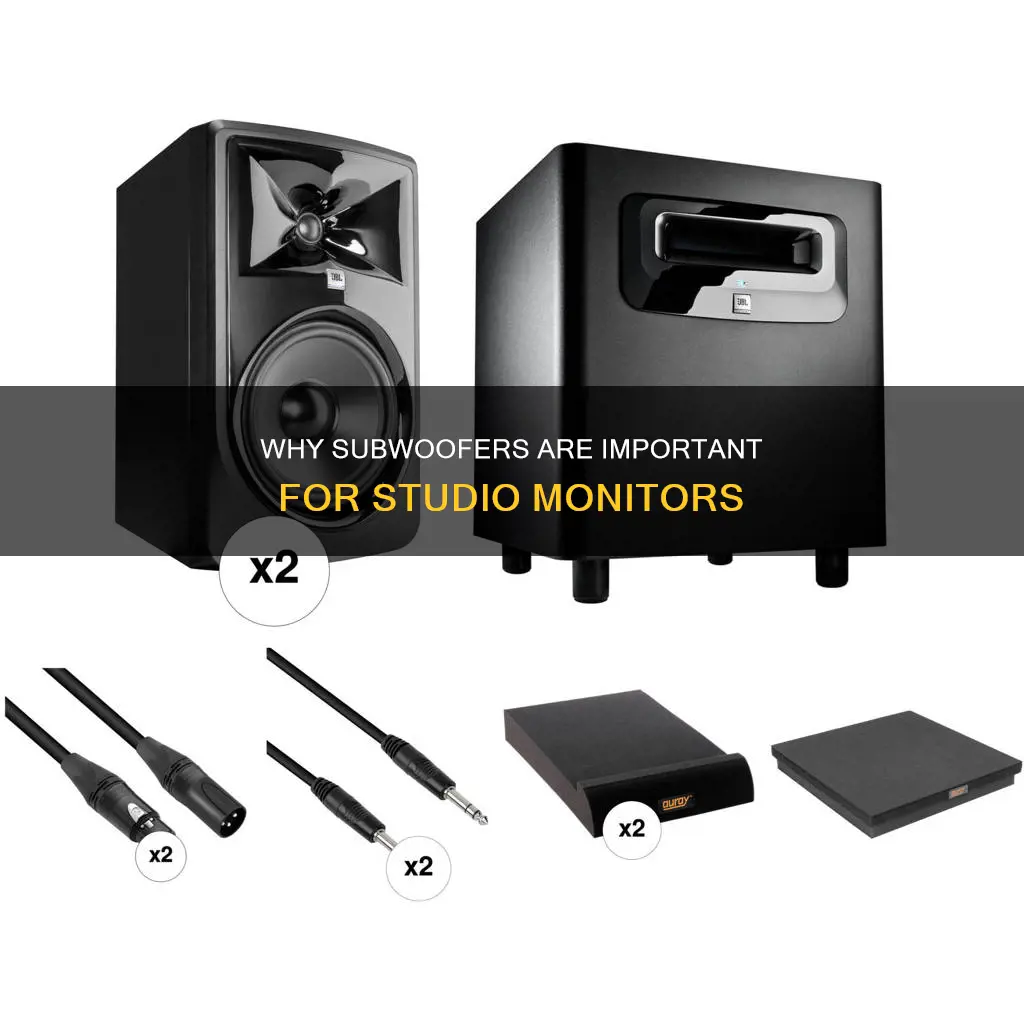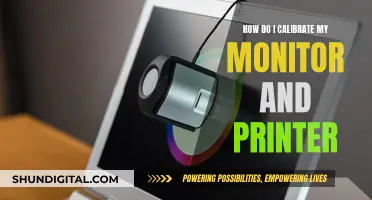
Music producers often struggle with getting the low-end right when trying to mix. One solution to this problem is to add a subwoofer to your studio monitor setup. Subwoofers are loudspeakers designed to handle low-frequency sound waves, typically in the range of 20 to 200 Hz, and they can provide numerous benefits to your studio setup, including improved accuracy in bass response, tactile response, and the ability to identify masking issues. However, simply purchasing a subwoofer and placing it in your room will most likely not give you the desired effect. Factors such as room size, shape, acoustic treatment, speaker placement, and calibration all play a crucial role in making a subwoofer effective. In this article, we will explore the benefits of adding a subwoofer to your studio monitor setup, the potential issues to watch out for, and provide guidance on how to set up and calibrate your subwoofer for optimal results.
| Characteristics | Values |
|---|---|
| Purpose | To improve the accuracy of bass response in music production |
| Use Case | Beneficial for electronic music producers, especially in small home studios |
| Benefits | Improved accuracy in bass response, increased headroom, more precise mixes, tactile response |
| Drawbacks | Requires proper placement, calibration, and room treatment; may exaggerate bass response |
| Room Considerations | Room size and shape matter; small rooms with parallel walls can create standing waves and phase cancellation issues |
| Speaker Placement | Subwoofers should act as a natural extension of studio monitors, placed to achieve the flattest frequency response |
| Calibration | Subwoofer level should be calibrated 3 dB below the level of studio monitors |
| Alternative Options | Larger monitors, studio headphones, acoustic treatment, plugins |
What You'll Learn

Subwoofers improve accuracy in bass response
Subwoofers are designed to handle low-frequency sound waves, typically in the range of 20 to 200 Hz. While regular studio monitors can reproduce some bass frequencies, a subwoofer is specifically designed to handle the extreme low end of the frequency spectrum, providing a powerful and precise bass response.
The tactile response of a subwoofer also allows you to accurately perceive how the bass physically feels in your room. This physical feeling can tell you a lot about how your low-frequency content is interacting with the rest of your mix. For example, you might realize the low end is too loud if the chest-rattling feeling is so strong that it masks other elements in different frequency ranges.
Additionally, subwoofers can help identify masking issues in your mix. If you're not getting that chest-rattling feeling when the bass hits, it may be a sign to turn up the bass a little so it hits harder.
However, it's important to note that simply adding a subwoofer to your setup may not give you the desired effect. Proper placement, calibration, and room treatment are crucial for a subwoofer to be truly beneficial. Room size and shape matter, as small rooms with parallel walls can create standing waves that make it difficult to accurately perceive the bass content.
In summary, subwoofers can significantly improve accuracy in bass response by providing a clear picture of the low-end frequencies in your mix and allowing you to feel the physical impact of the bass. With proper setup and calibration, a subwoofer can be a valuable tool for achieving accurate and powerful bass response in your studio.
Ankle Monitors: Who's Being Tracked and Why?
You may want to see also

They can be tricky to set up
Setting up a subwoofer with studio monitors can be a challenging task, requiring careful consideration of various factors. Firstly, room size and shape play a crucial role in determining the effectiveness of a subwoofer. Small rooms with parallel walls can create standing waves, resulting in phase cancellation and uneven bass response. To mitigate this issue, acoustic treatment such as bass traps in corners may be necessary.
Proper placement of the subwoofer is crucial. It should be positioned to achieve a flat frequency response between all speakers, acting as a natural extension of the low end of the studio monitors. This often involves avoiding reflective surfaces like walls or corners, as low-frequency reflections can create standing waves that distort the bass response.
Calibrating the subwoofer with studio monitors is another important aspect of the setup process. This involves adjusting the levels of the subwoofer and studio monitors relative to each other to ensure a smooth and balanced overall response. An SPL meter or app is typically used for this process.
Additionally, the choice of subwoofer model and type (passive or active, ported or sealed) should be made based on the specific needs, room size, and budget of the studio. Proper integration of the subwoofer with the existing studio monitors is essential, and room correction software may be required to fine-tune the system.
In summary, while subwoofers can enhance the low-frequency response of studio monitors, they require careful setup and room treatment to be effective. Improperly set up subwoofers can introduce more problems than they solve, so it is crucial to follow manufacturer guidelines and best practices during the installation process.
Monitoring Data Warehouse Performance: Strategies for Success
You may want to see also

They are not always necessary
Adding a subwoofer to your studio setup is not always necessary and may even cause more harm than good if you don't have the right space or setup. Most home studios are in small, square, or rectangular rooms, which can cause issues with standing waves and phase cancellation. Standing waves create an uneven bass response, with some notes over-exaggerated and others quieter. This issue is exacerbated in smaller spaces as the wavelengths of low frequencies are often larger than the dimensions of the room.
To get the most out of a subwoofer, you need adequate space and proper acoustic treatment. If your room is untreated or too small, you may be better off investing in your room's acoustics or a pair of studio headphones to get a clearer picture of your low-end frequencies.
Even with the right space, setting up a subwoofer properly can be challenging. Improper placement and calibration can lead to issues with the bass response and overall balance of your mixes. Therefore, it is crucial to consider room size, acoustic treatment, speaker placement, and calibration before adding a subwoofer to your setup.
Additionally, the type of music you produce should be considered. If you are not working in a genre that relies heavily on low-end frequencies, a subwoofer may not be necessary.
In summary, while subwoofers can provide benefits such as improved accuracy in bass response and tactile feedback, they are not always necessary. The decision to add a subwoofer depends on your studio setup, room acoustics, and the type of music you produce. If you have a small, untreated room or are unsure about proper subwoofer setup, you may be better off without one.
Monitoring and Evaluating Business Performance: Strategies for Success
You may want to see also

They can be used with headphones
Studio monitors are speakers that reproduce some bass frequencies, but a subwoofer is required to handle the extreme low end of the frequency spectrum. Subwoofers are designed to handle low-frequency sound waves, typically in the range of 20 to 200 Hz. They are a critical component of a professional studio setup because they allow you to accurately monitor and control the low-frequency content in your mixes.
That being said, subwoofers are not always necessary, especially if you are working in a small or untreated room. In fact, adding a subwoofer to a setup in an untreated room can do more harm than good, as it can exaggerate the bass response and create issues with standing waves and phase cancellation.
If you are working in a less-than-ideal space, a pair of studio headphones can be a good alternative to a subwoofer. Headphones can provide a lot of the low-end information that speakers can struggle with, and they are not affected by room acoustics. Mixing on headphones can present its own set of challenges, such as an overly wide stereo field and no crossfeed between the channels. However, using a combination of speakers and headphones can be a good solution, allowing you to get the best of both worlds.
Additionally, there are tools and plugins that can help replicate the physical bass feeling that you would get with a subwoofer. For example, Subpac makes a device that goes on the back of your chair and vibrates to give you a sense of that massive bass rumble.
So, if you are considering adding a subwoofer to your studio monitor setup, it is important to first ensure that your room is properly treated and that you have selected the right subwoofer for your specific needs, room size, and budget. If not, a pair of studio headphones might be a better investment.
Monitoring Data Usage: A Guide for Linksys Routers
You may want to see also

They are great for electronic music
Studio monitors are speakers that reproduce some bass frequencies, but a subwoofer is designed to handle the extreme low end of the frequency spectrum, providing a powerful and precise bass response. Subwoofers are a critical component of a professional studio setup because they allow you to accurately monitor and control the low-frequency content in your mixes.
Subwoofers can be a great addition to a home studio setup and are particularly beneficial for producers of electronic music. Here are some reasons why:
Accurate Low-End Monitoring
Adding a subwoofer to your system gives you a better chance of getting the low end just right. This is especially important for electronic music, where you want to achieve that thumping, club-like bass. With a subwoofer, you can accurately monitor the low end with pinpoint accuracy, ensuring your mixes translate well to different sound systems.
Tactile Response
While headphones and plugins can help you perceive the relationship between low-frequency content and the rest of your mix, a subwoofer provides the best way to physically feel the bass in your room. This tactile response gives you valuable information about how your low-frequency content is interacting with the rest of your mix.
Identify Masking Issues
The physical feeling of the bass in your chest can help you identify if the low end is too loud and masking other elements in different frequency ranges. Conversely, if you're not feeling that chest-rattling sensation, it may indicate that you need to turn up the bass a bit.
Extension of Main Speakers
A subwoofer can act as a natural extension of your studio monitors, filling in the bottom octave of the frequency spectrum. This not only gives you more accurate low-end information but also allows your main speakers to work more efficiently, as they don't have to produce as much sound in the energy-hungry low end.
In summary, a subwoofer can be a valuable addition to your studio setup if you're producing electronic music. It will provide you with accurate low-end monitoring, a tactile response, help identify masking issues, and extend the frequency response of your main speakers. However, proper placement, calibration, and room treatment are crucial to ensuring that the subwoofer enhances your setup rather than creates more problems.
Adding Users to Performance Monitor Group: A Simple Guide
You may want to see also
Frequently asked questions
A subwoofer is a loudspeaker designed to handle low-frequency sound waves, typically in the range of 20 to 200 Hz. While regular studio monitors can reproduce some bass frequencies, a subwoofer is specifically designed to handle the extreme low end of the frequency spectrum, providing a powerful and precise bass response. Subwoofers are a critical component of a professional studio setup because they allow you to accurately monitor and control the low-frequency content in your mixes.
Adding a subwoofer to your system gives you a better chance of getting the low end in that sweet spot where you feel its power, but it doesn't eat up the entire mix. This addition is particularly helpful for producers of electronic music, allowing you to accurately monitor the low end with pinpoint accuracy. Subwoofers also provide a tactile response, allowing you to physically feel the bass in your room and perceive how it interacts with the rest of your mix.
Room size and shape matter when using a subwoofer. If your studio is in a small room with parallel walls, standing waves can be created, making it difficult to control low frequencies. This can lead to phase cancellation, resulting in points in your room where certain frequencies are incredibly loud or quiet. Proper placement, calibration, and room treatment are essential to ensure that the subwoofer doesn't exaggerate the bass response and negatively impact the balance of your mix.







